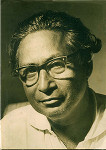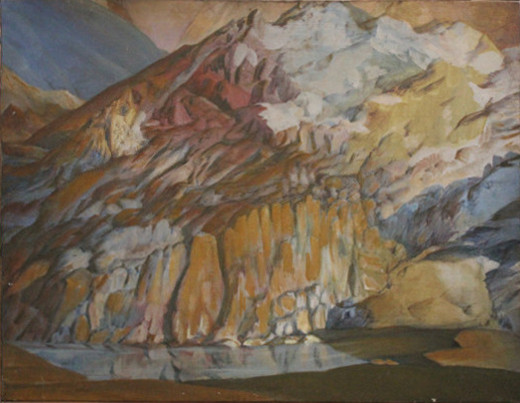
He was indeed a hermit - a hermit who dedicated his life to his worship - worship of art!
He spent years visiting the caves of Ajanta and Bagh, camping there days together - trying decode the secret techniques which imparted the sculptures and Murals their ethereal beauty. This relentless research poured itself into each and every piece of art he created - be it landscape, portrait or abstract paintings. His paintings have revealed a new direction in iconography and space organization.
He was a hermit, who preferred to live a secluded life, unbothered by the contemporary. He did not hanker for any accolades. Study and experiments of art was his life breath & he was completely devoted to this pursuit. He did get his share of success and recognition, but was not what spurred him any way. This made Shri Govind Madhav Solegaonkar, (fondly addressed as Dada), an unusual artist.
Many artists of his time were influenced by the British art - The drawing and composition in Indian painting were on the level of mere imitation and copy. He was one of the few artists of his time, who went beyond the mere superficiality of imitation. He sought inspiration in the traditional art of Ajanta and Bagh. However he was not just a revivalist content with nostalgic images of the past. He was vitally interested in the Present, with a deep rooted understanding of the past heritage. In his work there is an integration in the past and the present.
This hermit had a 'nomad' hidden within. He travelled the length and breadth of India with his palette and satchel of brushes. In his landscapes he would capture magnificence of Nature from Sahyadris to the wilderness of Himalayas. He gave the Midas touch bringing to life ordinary 'subjects' even from rural site. He had often given away many of his paintings to locals who helped his journey. For Dada, the joy and the urge for painting was a lot more important than the product itself.
Years of his research brought him to the stage of fruition. He was a very progressive artist with consummate skills in handling different styles of painting rather than be an ardent follower of a particular school. Dada always held that an artist's ingenuinity lies in controlling techniques and rules rather than getting restricted by them.
W.E. Gladstone Solomon, Dean & art director of J.J. School of Art, has gone on record to say 'G.M. Solegaonkar, is in my opinion one of the ablest students who have studied here during my regime. He is a brilliant young Artist in the Indian Style of Painting'.
Years later, during Europe tour when an exhibition was opened in Brussels L. Demulder Dutron, art critic, Brussels admired him saying: 'The Painting of G.M. Solegaonkar, create an atmosphere of meditation, of deep and concentrated feeling. It is not intended to appeal to shallow minds, to indifferent sensitivities. Here the attention is not attracted by the painting materials worked out in relief by rough rendering or by pasting. The rare vibrations that reach our intelligence honestly proceed from color and drawing. His works talk a universal language beyond time, a language that does not die at the bottom of one's heart. The rhythms are fascinating, bewitching and lead us where there is no room for narrow-mindedness. Whether the compositions are abstract or figurative we always discover an ardent soul attached to balance in the highest sense of term. The artist is painting devotionally, humbly and is always obedient to his inspiration and yet he is a master of his technique. All this gives to his talent an inner distinction that nothing will ever deaden. We hail in Solegaonkar a real painter, free from the conventions that restrain the liberty of expression. He remains deeply and sincerely himself.'
His paintings are a treasure for the world. Even today, some of them glorify the iconic walls of places like Mahatma Gandhi's birth place in Porbandar and the Indian Parliament.
The evergreen 'student' within him kept on working on new themes and techniques till the very end. To that effect Dada was an Art Pilgrim forever. A stage came in his life when he was satisfied that his search had become successful. He had discovered the master key. He was confident that the technique he evolved could achieve what the unknown great artists of the glorious past had strived for and produced. In his own words 'Posthumous recognition is the fate of an artist and I am a true artist. I am confident that the experiments I undertook have been fruitful. Adopting this method, success is guaranteed. Using a substrate prepared as per my technique is a sure shot guarantee for achieving unusual depths and visual magnificence in the art work.'
Such artists are beyond life and death, for their art lives on - and speaks volumes. Their works are the footprints that they leave behind on the sands of time. Here follows a sketch of his Life, Teachings and Work, with the hope that it may ignite some curious mind of a student of art.
